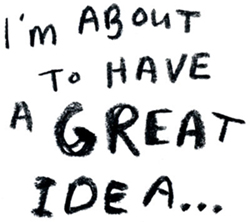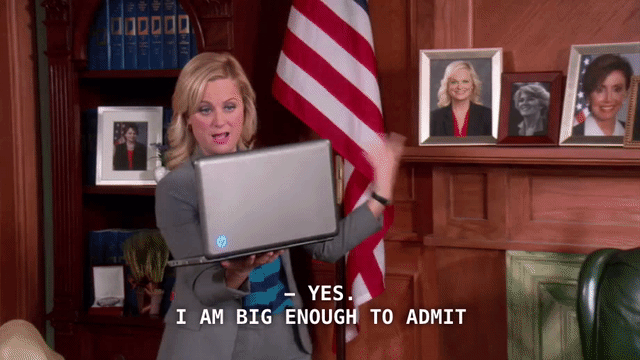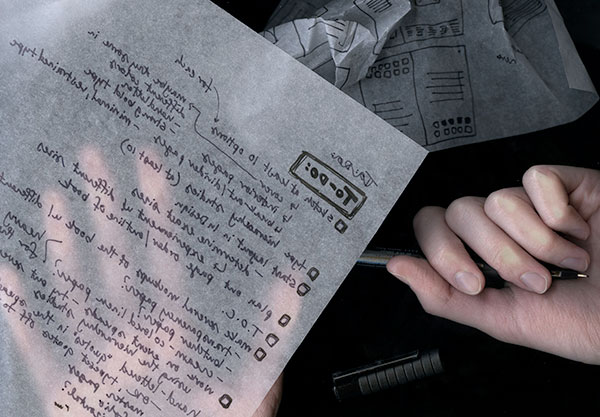
The more personal you can make your work, the more people it will touch. Everything starts with a knowledge of self.
—Jimm Lasser
We value most those designers who are capable of investing their work with personal statements.
—Adrian Shaughnessy

The first step in the design process (before we can even get to the concept) is picking a topic. It’s daunting to think of one when you have unbounded freedom to do anything your heart desires on any subject under the sun.
Sometimes you fall in love with a project right off the bat. Other times you go back and forth between ideas for days or even weeks. There’s no reason to go forward with a project if you’re not first passionate about the subject. That should be all you need to know, but somehow our desire to be Hot Shit gets in the way and ruins everything.
To come up with a good idea, you should first start by fully exhausting every possible brainstorming exercise you can think of: mind-mapping, list-making, map-tracing, note-taking, journaling, drawing, sketching, doodling, scribbling, talking with your professors and peers, asking for advice, going for long walks, taking a shower, devouring the internet, reading books, looking at stuff, talking with friends, talking out loud to yourself, listening to music, going to a museum, sitting in a park, going for a drive, drinking a beer, sitting, thinking, pondering, analyzing, dreaming, running, skipping, jumping, dancing, singing, crying, praying, rocking back and forth, frolicking through a meadow, talking to your spirit animal, deciding to quit only to trick yourself into reigniting your creative juices, falling asleep on the couch in hopes that you might wake up from a dream about your perfect idea, consulting a psychic, etc.

And even after all that, sometimes you realize the topic you chose isn’t actually what you want to work on after all. What you thought would be fun, might actually be miserable the more you think about it. If that’s the case, you might consider changing your project (given there’s enough time to do so). The question you’ll have to ask yourself is, Am I going to feel relieved to switch my topic at this point? If the answer is Yes, do it. You don’t have to do anything you don’t want to do, because you are in charge of your own project (yay!). Isn’t it fun being a creative person?

Because in the end, it’s all about your work and your portfolio. The projects that are hard to get passionate about are the ones that always get put on the back burner and eventually, moved to some folder titled “whateverrrr” on your computer and never seen again. The ones you are passionate about are the ones you work your ass off for, and the ones that people notice. People will be more interested in your work if they can tell you’re excited about it and so there’s no better way to approach projects than to just be kinda selfish. It sounds wrong, but sometimes you gotta be indulgent. Sometimes you gotta go against the grain. Sometimes you gotta be obsessive, bordering on ridiculous. The good news is that school gives you the allowance and freedom to do that.
You know you’ve found your topic when you’re not bored anymore.

I love being able to make my work as personal as possible. And as it turns out, a few other people do too.1 That said, an easy way to narrow it down is to stop thinking of “good ideas” and start thinking about what you love. And although you can’t necessarily force yourself into being passionate about something, you can at least start with an insatiable curiosity. So start there. Your good idea will come out of that. You know you’ve found it when you’re not bored anymore.
The ego is not supposed to be involved in graphic design. But I find that for myself, without exception, the more I deal with the work as something of my own, as something that is personal, the more successful it is as something that’s compelling, interesting, and sustaining.
—Marian Bantjes
An Interview with:
Jordenn Bailey (2016 grad)
1.You seem to have a really good handle on craft and production in general. What’s your approach?
It’s all in the details. I think I found templates online for a lot of what I built, but for every one I had to tweak/customize them because they weren’t correct or accurate. I also made sure to approximate real world versions as closely as possible. Every detail of your piece is critical for bringing authenticity, whether it’s an album cover, beverage package, chocolate bar, postage stamp, movie poster—they have more of a real feel if you get those little details right.
I also try to research materials (paper, cardstock, binding tape, rivets, etc.), and even design to a material if it makes sense. And tons of print tests. Tons! I burned through so much ink on each of my projects leading up to Review, but it really informed the work. You don’t want to skimp on that. Make sure you have backup ink cartridges too. 2:00am and running out of ink before a deadline where you then have to hustle over to Lloyd Center FedEx (open 24/7!), pay for prints, and then back home to trim and assemble is really no fun. Well, it’s a little fun. ;^)
Be sure to explore all the nooks and crannies of your local art and hardware stores too, you’d be surprised what kind of inspiration you’ll get from seeing lots of different materials and methods of attaching things together.
And lastly, if you can manage it, do a lot of assembly tests. Work with paper mockups, then move on to card or whatever is your final material. The more bugs you can work out early the better. It will give you time to redesign a piece to work around a flaw in a material. Also try to be rested before you do a final assembly. Again, 2:00am is a great time to slice a finger or destroy a seam with a bad glue join. ATG glue guns (arts stores have them in pocket sizes, and varying stickiness) are a lifesaver when you know you’re going to have to place and reposition tricky elements. This was key on my album cover and beverage package projects.
2.Commissioning pieces can be spendy, yet sometimes not even worth it. How do you know when to go with a professional?
You probably mean how a spent $150+ on my portfolio cover. ;^) I wanted to have a hardcover, clothbound book feel to my portfolio, but new I wouldn’t have time to build that myself and get all the other pieces done in time. So I found a great place in LA that does custom builds, and went the extra step and had them emboss my name on the cover. It looks amazing, is great quality, and should last forever. I was okay with the price because it’s a commemoration of a ton of hard work, so why not wrap it in something special? And they did great work, so it just brought everything up a notch in presentation.
3.What’s your advice on overcoming issues with craft/production? Any specific lessons you’ve learned?
A lot of roadblocks come from being too tired to solve the problem in the moment. Sleep on it if you can, and the solution should come to you. Also, it really helps to ask around for tips/suggestions—you’d be surprised how a handy friend or relative will have a crazy perfect take on how to execute something you were literally banging your head on a desk trying to figure out. Instructors too! They love to help problem solve this stuff.
As for lessons, banking enough time to build a piece is key. Learn what you’re estimating multiplier is. If you always think it’s going to take 3 or 4 hours but it’s really all night and into the morning, then you need to 3x that estimate next time. So instead of Sunday night you should start on it first thing Friday. That kind of foresight helps you deliver at a higher level, because you now have time to work out the kinks, go back and tweak files and reprint parts that aren’t working. You have time to drive back and forth to the printer, or run back to the art store for more supplies (at a time when they’re open), or even time to wait for your inkjet to physically print the job out. All those little bits of time add up to really long nights if you don’t prepare ahead. So the biggest thing for me is to start early so I have time to fail and fix along the way.